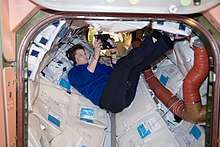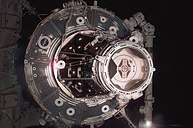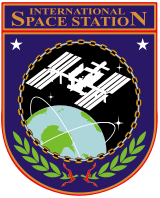Pressurized Mating Adapter
The Pressurized Mating Adapter (PMA) is a spacecraft adapter that converts the Common Berthing Mechanism (CBM) used on the US Orbital Segment to APAS-95 docking ports. There are three PMAs located on the International Space Station (ISS). The first two PMAs were launched with the Unity module in 1998 aboard STS-88. The third was launched in 2000 aboard STS-92.
Uses

All the PMAs on the ISS are identical[1] but used slightly differently, and all three perform the same basic function of connecting a Common Berthing Mechanism port of an ISS module to an APAS-95 docking port of another module or visiting spacecraft.[2] For this the PMAs carry a passive CBM port and a passive APAS port. They are pressurized and heated from the inside, and through docking rings as well as external connections allow for power and data communications transfer.[3]
PMA-1
This was one of the first components of the International Space Station and joins the Russian side of the station with the US side. On STS-88 the crew used the shuttle's robotic arm to attach the Zarya control module to PMA-1, which was already connected to the aft berthing port of Unity. PMA-1 now permanently connects these first two station components.
PMA-2

PMA-2 is mounted on the forward port of the Harmony connecting node and was used when Space Shuttle orbiters docked at the station. It is the only PMA that has been outfitted with Station-to-Shuttle Power Transfer System (SSPTS) hardware, which allowed shuttles to stay docked longer to the space station.[4] Due to space station assembly PMA-2 has been moved several times. It was originally connected to the forward hatch of Unity, but when STS-98 delivered the Destiny in February 2001, Destiny was berthed to that hatch while PMA-2 was moved to the berthing ring of the Z1 truss. It was finally moved to the forward hatch of Destiny.[5] (The removal of PMA-2 from Unity was the first time the Common Berthing Mechanism (CBM) was used to disconnect two ISS components.[6]) After STS-120 had delivered Harmony at the station in October 2007, Canadarm2 relocated PMA-2 to its final location at the forward hatch of Harmony on November 12, 2007. Two days later, the combined package of Harmony and PMA-2 was moved to its final location, the forward hatch of Destiny. As of 2020, PMA-2 is staying berthed at the forward port of Harmony for the remaining duration of the ISS. When a shuttle docked with the station, its "final approach [was] at a relative velocity of one-tenth of a foot per second. [As it made] contact with Pressurized Mating Adapter 2 [latches] automatically attached the two spacecraft together. Once relative motion between the spacecraft stopped, [a Shuttle astronaut retracted] the docking ring on [the Shuttle's] mechanism, closing latches to firmly secure the shuttle to the station."[7] International Docking Adapter-2 was launched on SpaceX CRS-9 on 18 July 2016.[8] It was attached and connected to PMA-2 during a spacewalk on 19 August 2016.[9]
PMA-3
In October 2000 STS-92 brought PMA-3, mounted on a Spacelab pallet, to the station.[10] It was initially attached to the nadir (bottom, or Earth-facing) hatch of Unity. One and a half months later, when STS-97 delivered the P6 solar array truss structure, Endeavour docked at PMA-3.[11] Also, when STS-98 moved PMA-2 from Unity to Destiny via Z1, Atlantis was docked at PMA-3.[5] PMA-3 was not used for Shuttle dockings for the rest of the shuttle's operation. PMA-3 was moved in March 2001 to Unity's port hatch by the crew of STS-102 to make room for the docking of a Multi-Purpose Logistics Module (MPLM).[12] On August 30, 2007, PMA-3 was moved to the nadir port of Unity to make room for the temporary docking of the new Harmony module that was delivered by STS-120.[13] Harmony was transferred to the forward port of Destiny, while PMA-3 was moved back to the port berthing mechanism of Unity on August 7, 2009, to accommodate reconfiguration of the Unity port bulkhead by crew members in a pressurized environment.[14] On January 25, 2010, PMA-3 was moved from the port berthing mechanism of Unity to the zenith (space facing) port of Harmony to make room for the new Tranquility (Node 3) module which was added to the station during STS-130. After activation of Tranquility, PMA-3 was moved again on February 16, 2010 to the port location on Tranquility where the Cupola had been docked for launch.[15] PMA-3 was robotically removed March 26, 2017 from the Tranquility module and attached to the Harmony module after being prepared during a successful spacewalk on March 24, 2017. A second spacewalk was conducted on March 30, 2017 to finalize the PMA-3 cable connections on Harmony. PMA-3 received the International Docking Adapter-3 adapter in August 2019.[16]
See also
- Spacecraft docking and berthing adapters
- International Docking Adapter
- Assembly of the International Space Station
References
- Nasa.gov – Elements
- "Human Space Flight – Space Fact". NASA. 2002-07-04. Retrieved 2007-01-17.
- "STS-92 Press Release Kit: Payload section". NASA. 2000-10-10. Retrieved 2007-10-27.
- "International Space Station Status Report #07-08". NASA.
- STS-98, Mission Control Center (February 10, 2001). "Status Report # 07". NASA. Retrieved 2007-01-18.
- Harwood, William (February 10, 2001). "Atlantis crew to attach Destiny lab to station today". Spaceflight Now. Retrieved 2007-01-15.
- STS-102, Mission Control Center (March 9, 2001). "Status Report # 03". NASA. Retrieved 2007-01-18.
- Jason Rhian (18 July 2016). "SpaceX Conducts Second Ground Landing After Launch Of CRS-9 Dragon To ISS". Spaceflight Insider.
- Harwood, William (19 August 2016). "Spacewalkers attach docking adapter to space station for commercial vehicles". Spaceflight. Retrieved 20 August 2016.
- STS-92, Mission Control Center (October 16, 2000). "Status Report # 10". NASA. Retrieved 2007-01-18.
- STS-97, Mission Control Center (December 2, 2000). "Status Report # 05". NASA. Retrieved 2007-01-18.
- STS-102, Mission Control Center (March 11, 2001). "Status Report # 07". NASA. Retrieved 2007-01-18.
- "SHUTTLE/SOYUZ/ISS PROCESSING MILESTONES". CBS News.
- "NASA - 08-07-2009 ISS On-Orbit Status". www.nasa.gov. Retrieved 2017-06-03.
- STS-130, Mission Control Center (February 16, 2010). "Status Report # 17". NASA. Retrieved 2010-02-16.
- Pietrobon, Steven (August 20, 2018). "United States Commercial ELV Launch Manifest". Retrieved August 21, 2018.
External links
| Wikimedia Commons has media related to Pressurized Mating Adapters. |
- YouTube animation Canadarm2 and Dextre move the PMA-3 between locations, one of the five times it was moved so that modules could use a Common Berthing Mechanism port instead of PMA-3.



